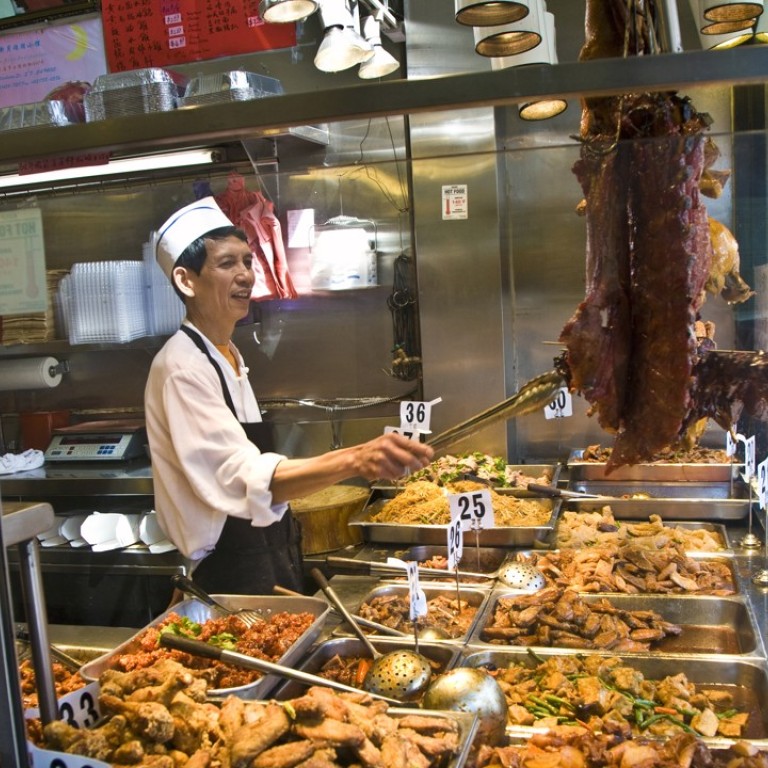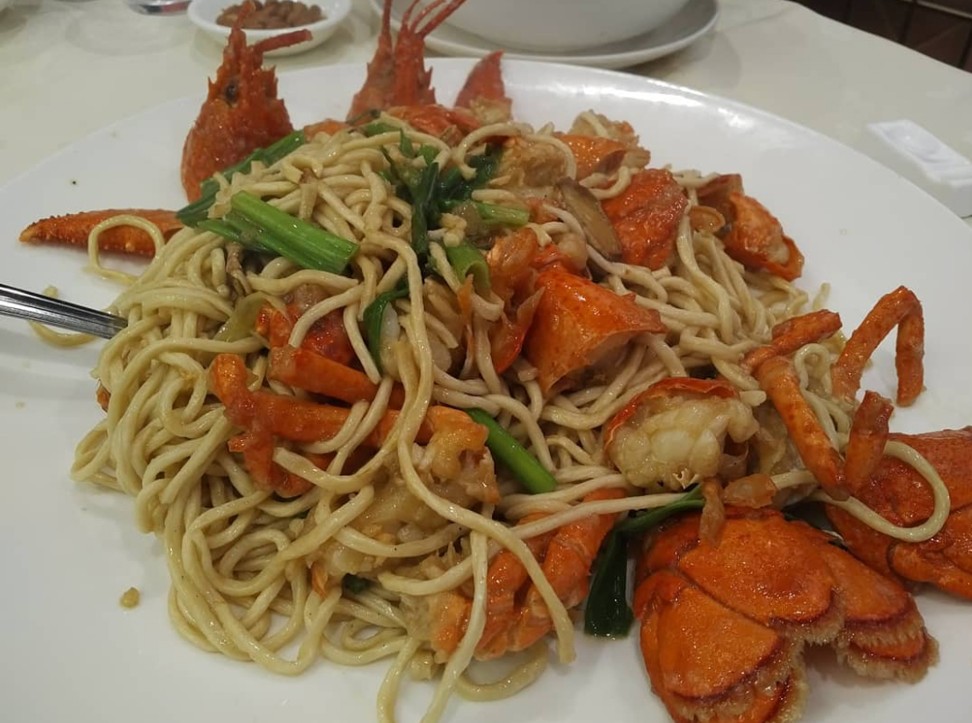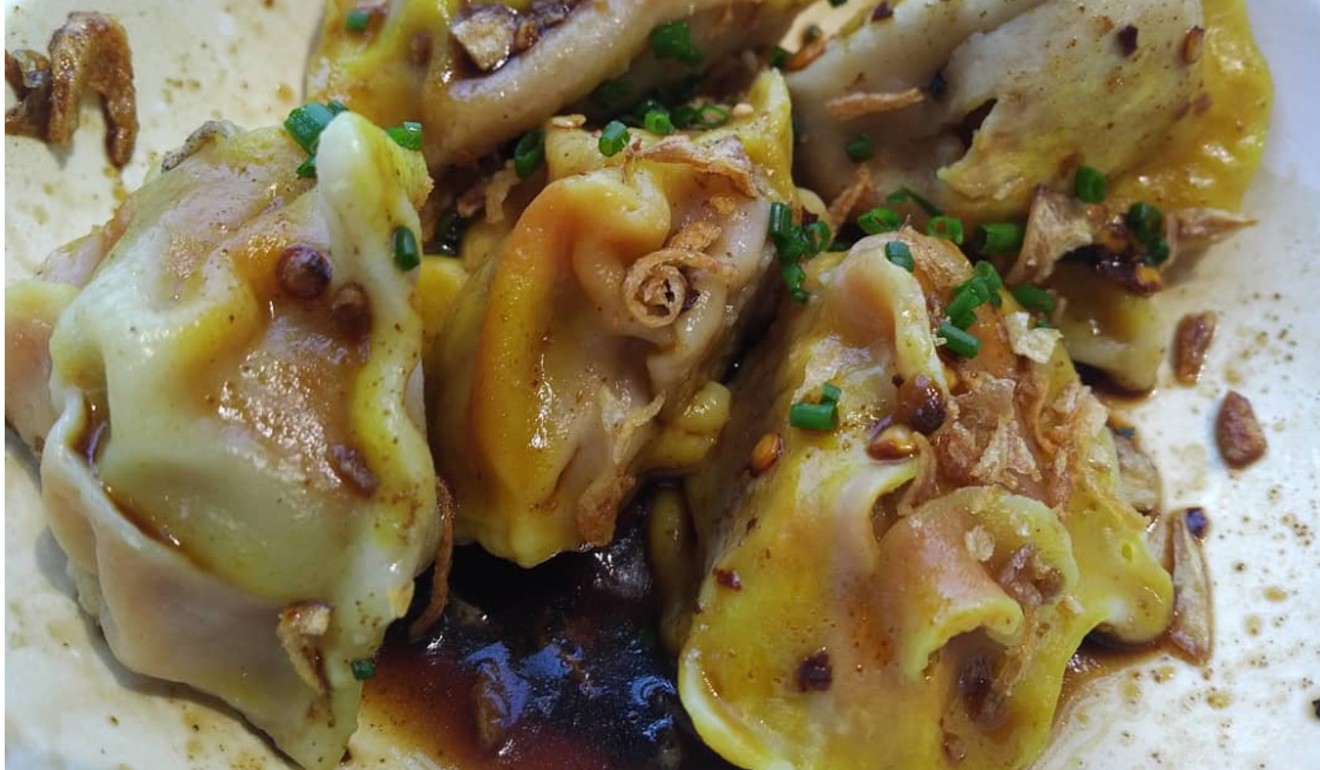
The man who has eaten at more than 7,300 Chinese restaurants, but can’t use chopsticks and doesn’t care for food
David R. Chan’s love of lists and determination never to eat at the same place twice has seen him become an accidental expert on Chinese-American history. Just don’t call him a foodie
David R. Chan is the very embodiment of the word “unassuming” – he seems to shrink behind the restaurant table, peering out over plates of pork buns, fried tofu and steamed vegetables. Retiring he may be, but this is 70-year-old Chan in his natural environment. There is likely no American alive with more experience dining in Chinese restaurants. At last count, he had eaten at 7,392 of them in the United States alone.
Chan is, in almost every way, an unlikely Chinese culinary celebrity. He cannot use chopsticks and does not drink tea (too much caffeine). He cannot speak Chinese. He adheres strictly to a lifelong low-sugar, low-cholesterol diet. He does not like spicy food. He does not, in fact, care much for food at all. Chan is adamant that he is not a foodie. His now-famous list – the spreadsheet of Chinese restaurants he has been keeping for almost four decades – does not even mention what he orders at the establishments he visits.
Chinese food is the new haute cuisine of choice for America’s rich
For Chan, the thousands of eateries where he has been served over the years do not appeal to him as a diner but as an accountant.
“This is just another Excel spreadsheet,” he says. “I was always into lists.” Chan is also a consummate collector. “I’ve collected stamps, went through coins, went through records, baseball cards.”
But, with American-Chinese restaurants, he might have bitten off more than he can chew.
The US is experiencing a boom in Chinese dining, with restaurants opening at a blistering pace, and this is certainly true in the Los Angeles area, where Chan has lived all his life. And Chan, in his own quiet way, loves a challenge. What’s more, thanks to his having recently retired from his job as a certified public accountant and lawyer, he has plenty of time to devote to eating.
While he may present himself as a “numbers guy”, Chan is, above all else, a historian. Awarded a bachelors in economics, a masters in business administration, and a law degree from the University of California, Los Angeles, it was his experience in the school’s first ethnic studies course on Chinese Americans that made the biggest impression.
I was always an American-history buff, so this was fascinating to me. There was next to no academic history of Asian Americans, no textbooks, no nothing
“I was always an American-history buff, so this was fascinating to me,” Chan says. “There was next to no academic history of Asian Americans, no textbooks, no nothing, so everybody who took that first class was basically on the ground floor of an academic subject.”
Chan wrote two papers for the class: one on the history of Chinese people in Los Angeles, and the other on the Chinese Exclusion Act of 1882, which prohibited the immigration of Chinese labourers. What he did not know was that one day he would be considered a trusted voice on those topics, or that his words and opinions would be printed in national newspapers and magazines, or that he would learn almost everything he knows from restaurants.
For both Chan’s story, and that of Chinese food in America, we must go back more than 100 years to a small, rural backwater called Taishan, in southern China.
Today, Taishan is a city in southern Guangdong province, and home to more than 900,000 people. But, for most of its history, it was little more than a farming community, and by the mid-19th century, it was impoverished to the point of desperation. When gold was discovered in California, in 1848, many of the Taishanese leapt at the chance to escape from poverty and, they hoped, strike it rich in faraway America.

The California Gold Rush lasted for less than a decade, but in that time, 4,000 Chinese immigrated to the US, almost all of them men and almost all from Taishan. Most settled in northern California, in and around San Francisco. (San Francisco is still known to many Chinese as jiujinshan, or “old gold mountain”.)
Among the Taishanese who came to San Francisco were Chan’s grandparents.
It was at this time that Chinese cuisine began to gain popularity with white American diners, as much for its exotic reputation as for its taste.
The Chinese Exclusion Act, the first in a series of statutes that would effectively end immigration from China until the 1940s, was catastrophic for the development of Chinese communities in the US. Cantonese was effectively locked in as the language of American Chinatowns, and the cuisine that Chan calls a “mutation” of rural Guangdong fare became cemented in the American psyche as “Chinese food”.
Chinatown was basically an ethnic amusement park, with restaurants for tourists and no real residential areas. We’d go to Chinatown for two things: banquets for somebody’s birthday or a wedding, or if we had relatives visit from out of town
“The Toisanese [Toisan being Taishan in the local dialect] brought the food that they knew with them, and that formed the basis of what – until the late 1960s – Americans thought of as Chinese food,” says Chan. “But in fact, it was really just food from this small rural area, and that had been adapted for ingredients found in the United States and to the tastes of local populations. You’re talking about stuff like sweet and sour pork, and chop suey, which is certainly not what you’d find in China.”
That was the Chinese restaurant cuisine of Chan’s childhood and young adulthood, which helps explain why the family ate out so rarely.
“Chinatown was basically an ethnic amusement park, with restaurants for tourists and no real residential areas,” he says. “We’d go to Chinatown for two things: banquets for somebody’s birthday or a wedding, or if we had relatives visit from out of town.”
Not that the food his mother was cooking at home was much better. “I hated it! Pigs’ feet in tomato sauce; ground pork with pickled turnips,” Chan recalls, visibly uncomfortable. “The thought of these dishes still makes me nauseous.”

It was in this gastronomic crucible that Chan developed a taste for what would remain one of his favourite dishes well into adulthood: soy sauce on rice.
In 1943, five years before Chan was born, the Chinese Exclusion Act was repealed. What replaced it was not much better.
“They put Chinese people under the existing national origins quota system, which meant each country’s immigration quota was proportionate to that country’s representation currently in the United States,” Chan says.
The largest quota went to Britain, which was so generous it actually went unfilled. China, on the other hand, was given an immigration allowance of just 105 people per year. That situation would remain mostly unchanged – with a few annual exceptions – until 1965, when a new act was drafted to remove racial bias from America’s immigration laws.
By the mid-1960s, immigration quotas may have been lifted, but the US and the People’s Republic of China still did not have a diplomatic relationship. They were, Chan says, “effectively at war”.
These chefs were a generation removed from China. By the time they moved from Taiwan to the United States, they were already removed from the origin of the food [...] They were opening restaurants for native New Yorkers, serving food to suit their tastes
As a result, the new wave of Chinese immigrants to US shores came almost entirely from Hong Kong and Taiwan. Hong Kong’s Cantonese-speaking residents felt right at home in the West Coast’s traditional Cantonese-speaking enclaves, while the Mandarin-speaking Taiwanese tended to migrate to the East Coast, setting up in New York.
Taiwanese immigrants could trace their roots all over China, and it was through them that Americans had their first taste of “regional” Chinese cuisine. Sichuan and Hunan restaurants proliferated on the East Coast and were, as Chan puts it, “a sensation”.
Still, the food they served was a far cry from the authentic Sichuan and Hunan fare common in the US today, or the food found in mainland China.
“I refer to that as faux Sichuan and faux Hunan,” Chan says. “These chefs were a generation removed from China. By the time they moved from Taiwan to the United States, they were already removed from the origin of the food. And there were basically no natives of Sichuan or Hunan living in New York, or anywhere in the United States. They were opening restaurants for native New Yorkers, serving food to suit their tastes.”

From the late 60s, chefs in the US could not have produced authentic Sichuan cuisine even if they knew how. The Sichuan peppercorn, an irreplaceable ingredient in most Sichuan food, famous for the numbing sensation it produces in the mouth, was made illegal in the US from 1968 until 2005, because of fears it might carry a disease that could infect America’s citrus crop.
Soon, more mild dishes from Sichuan, by way of Taiwan, by way of New York, such as kung pao chicken, hot and sour soup, and sizzling rice soup were appearing on menus across the US.
As Americans’ taste for this so-called Hunan and Sichuan food spread west, Cantonese remained king in California: no longer the watered-down takes on Taishan delicacies, but recipes straight from the kitchens of Hong Kong.
This was the mid-1970s, when Chan’s dining habits began to escalate. By the end of the decade, Chinese restaurants had proliferated to the point that Chan was afraid he would unknowingly eat at the same place twice and the famous list was born – initially using pen and paper. When he bought his first personal computer, in 1992, he had an idea: why not use this new technology to keep a list?
In 1978, people in LA started talking about this great new Hong Kong-style restaurant that had opened up in San Francisco [...] My wife and I flew up in the morning, ate there for lunch, ate there for dinner, then flew back in the evening. It was so much better than anything we’d had
Chan’s work responsibilities took him all over the US. Looking for a way to kill time on the road, he began “collecting” Chinese restaurants with gusto, eating at as many as four establishments a day.
While his tastes still tended towards “pasta without sauce”, Chan was fascinated by the changes he saw in Chinese restaurants across the country. At home, talk of new and better Chinese restaurants was on everybody’s lips. In retrospect, he says, the first time he heard it was in the late 70s.
“In 1978, people in LA started talking about this great new Hong Kong-style restaurant that had opened up in San Francisco,” Chan says. “It was called Kam Lok. People from LA would fly up there just to eat. My wife and I flew up in the morning, ate there for lunch, ate there for dinner, then flew back in the evening. It was so much better than anything we’d had here.”
Two years later, Chan made his first trip to Hong Kong.
“We saw all these restaurants selling seafood. It was something we’d never seen before,” he says. “Then, we came back to LA and, six months later, all of these seafood places started opening up. Within two or three years in LA’s Chinatown, San Francisco’s Chinatown, New York’s Chinatown, every new Chinese restaurant had seafood, or ocean, or something like that in its name.”

The boom in Hong Kong-style cooking in the mid-70s began before the waves of immigration to North America over the two decades that followed, as Hongkongers started to leave home ahead of the return of the British colony’s sovereignty to China in 1997. Among them were numerous Cantonese chefs.
While many of those immigrants settled in Canada, enough made their homes in California to usher in what Chan calls the “golden age of Cantonese food in the United States”, from the mid-80s to the early years of the new millennium. It was the last time Cantonese would dominate Chinese-American dining.
In 1979, the US and China normalised diplomatic relations, but changes in the Chinese-American community were slow coming. China was a predominantly agrarian society, with economic develop-ment limited to urban centres such as Shanghai, Beijing and Guangzhou.
Now Chan’s list started telling a new story: for the first time, Shanghainese restaurants were making an appearance, and their numbers burgeoned in the late 80s.
For Chinese immigrants, the American dream is over
For many Americans, this was the first time they had tasted authentic non-Cantonese food – and they gobbled it up. Especially in San Francisco, Shanghainese cuisine came to dominate Chinese dining. No one doubted that Shanghainese food would become the new cuisine of Chinese America.
It was in 2012 that Chan himself was discovered. He had been posting on food-related message boards such as Chowhound for 13 years, and when it became known that he had eaten at what was then more than 6,000 Chinese restaurants, journalists started contacting him for food stories. They were, however, confounded by his apparent lack of interest in food, as was he by the editorial process.
That same year, the Asia Society in New York commissioned a story on Chan’s favourite Chinese restaurants. Chan wrote back with a dry list. When the editor followed up, asking why his list only contained places in California and none in New York, he replied with a casual aside, explaining how, in his opinion, New York Chinese food had been stagnating for years as immigration patterns shifted, and was rotten compared with that available in California.
Without Chan’s permission, the editor published his aside along with his list.
“I was horrified,” Chan says. “That was not meant for public consumption, but that thing hit such a nerve.”

The story went viral and was even retweeted by the food editor of The New York Times. Chan did not know it, but he had waded into one of the most contentious food debates in the country.
“The first reaction I saw was on a message board about New York restaurants,” he says. “It was just nine pages of personal attacks.”
While both coasts continued to squabble over the merits of their Chinese food, China’s financial boom would remake Chinese dining in the US almost entirely and faster than anybody could have anticipated.
As China prospered, Chinese people started visiting the US in greater numbers.
“About 10 years ago, there was a notable shift in the foreign buyers of single family residences in the United States,” Chan says. “Until 10 years ago, the percentage of all foreigners buying houses in the United States who were Chinese was 10 per cent. Ten years later, that number is 30 per cent.”
Increasingly, especially in cities with large Chinese populations, new arrivals began to demand dishes from their home regions. Chefs came from mainland China as well, and for the first time were cooking for Chinese consumers, without having to worry about white-American tastes.
Chinese buying of US residential property hits record high
As the economies in both countries continue to boom, the US is proving increasingly appealing to Chinese restaurant groups, which are flocking across the Pacific.
That is not an entirely new development: as early as the 80s, says Chan, Beijing-based duck restaurant Quanjude opened a franchise in Los Angeles, but “failed miserably”. Today, however, success is easier to come by.
Hong Kong dim sum restaurant chain Tim Ho Wan has a location in New York and one on the way in southern California; Da Dong – another Beijing-based duck restaurant – has opened an opulent formal dining room in New York; and billion-dollar hotpot company Haidilao has opened in Arcadia – a city outside Los Angeles that is known to locals as the Chinese Beverly Hills.
In short, the Chinese food landscape in the US is unrecognisable from even a decade ago, which Chan proved to himself earlier this year when he decided to do something he tries never to do: go back to a restaurant for a second time. All the new Chinese restaurants had him thinking about Kam Lok, the San Francisco Cantonese restaurant considered so good that it had been worth flying to back in 1978.
“It’s still there, in the same location,” Chan says. “The restaurant looked the same, the menu looked the same, but we thought the food was awful.”
It was not that the food had changed, but that it had, indeed, stayed the same.

